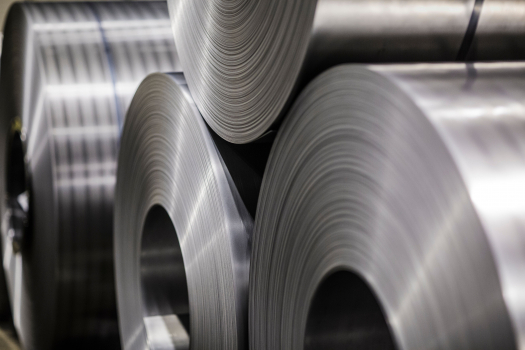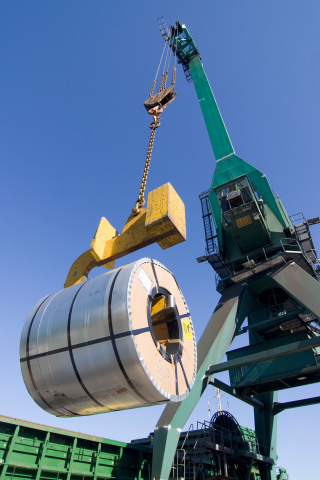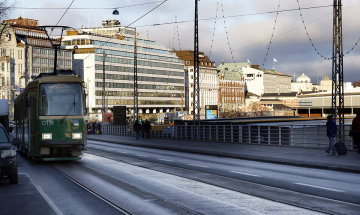
Major investment to reduce Finland’s carbon dioxide emissions by 7 per cent – SSAB’s investment and business are a prime example of the technology industry’s handprint
It took four years. Steel company SSAB, which acquired Rautaruukki, began a study in 2016 to identify whether it could revolutionise the manufacturing of steel – humanity’s most widely used material – and take the substantial carbon dioxide emissions involved in steel production down to zero. SSAB is now beginning to alter its factories in phases. The company will begin manufacturing steel using hydrogen reduction, so the process will only output water – not emissions.
“Our original target was for 2035, but we wanted to get our skates on. We have now pledged to our customers that we will be able to supply steel that is free from fossil carbon on the European and North American markets in 2026. We are making major changes to our factories, and we have a plan for the pace of reconstructing our factories. The last of them will be completed around 2040,” says Harri Leppänen, Head of EHS at SSAB.
Our original target was for 2035, but we wanted to get our skates on.
In Raahe, the changes will come to fruition in 2029. The Raahe steel factory currently accounts for 7.5 per cent of Finland’s emissions.
“When we have finished, our emissions will be 10 million tonnes lower on a global scale and 9 million tonnes in the Nordic countries. This amounts to 7 per cent of Finland’s total carbon dioxide emissions and 10 per cent of Sweden’s,” Leppänen says.
Competitors are interested in the technology
Metal processing is one of the most important branches of the technology industry and one of Finland’s largest emitters of greenhouse gases. The positive impact of SSAB’s major investment on Finland’s climate actions is immense.
In terms of sustainable development, one special characteristic of the technology industry is its large handprint: the technology industry’s products and services also enable significant reductions in emissions in the operations of customers in the industry.
Harri Leppänen, Head of EHS at SSAB, believes that the company’s hydrogen reduction solution has enormous market potential.
SSAB has a large handprint because the fossil-free steel it produces will be used in other industries, and the company can sell its technology globally. High quality and the efficient use of energy and materials have always been among the strengths of the Finnish technology industry’s products, and these characteristics have provided customers with low emissions and savings in operating costs.
“We believe that competitors will be interested in this technology as the world is rapidly heading towards a state where carbon dioxide must be eliminated from production. Customers are also beginning to demand this, so we strongly believe that our product has market potential.”
Research, innovation and electrification are key factors
Technology Industries of Finland is committed to the Finnish government’s target of making Finland carbon-neutral by 2035. The industry is using a low-carbon roadmap to identify which technologies and measures are needed to reach the target.
According to a technology study prepared during the first phase of the roadmap, the most effective ways of reducing the industry’s direct emissions are innovations such as SSAB’s hydrogen reduction, as well as the electrification of machinery and equipment. For example, the work machinery and cranes used in mining and industry can be converted to run on electricity.
Work machinery and cranes can be converted to run on electricity.
In addition, energy efficiency, waste heat recovery, the circular economy and digitalisation offer significant opportunities for rapidly reducing emissions in technology industry companies and their customers. However, the actions will require substantial investments, the availability of affordable clean electricity and targeted inputs into research and development.
The availability of emission-free electricity must be safeguarded
Leppänen believes that the EU, which is committed to combating climate change and transitioning to new technologies, will offer to help companies with large investments. In addition, the availability of competitively-priced, emission-free electricity and a comprehensive electricity grid will be extremely important.
“When all of our production is operating using hydrogen reduction and recycled steel, we expect our electricity consumption to be 6–7 times higher. The only way this will make sense is if the electricity we consume is also produced without carbon dioxide. However, we believe that wherever there is a demand for electricity, there will also be a supply,” Leppänen says.
SSAB is constantly engaged in product development and studying the possibilities for entirely new types of steel.
The electricity grid or the price of electricity must not be the bottleneck that holds back climate actions because electrification is increasing in all industries and sectors of society, such as transport.
“In addition, we should consider whether the electricity grid should be designed to satisfy Finland’s needs alone or whether we should also consider our opportunities for producing CO2-free electricity in order to attract investments to Finland. Electricity and zero emissions are also valuable for our image and national economy.”
Fossil-free steel is a business
The low-carbon Nordic electricity network was beneficial when SSAB set out to test how fossil-free steel could be made in a large steel factory rather than a laboratory.
“For example, in Germany, the availability of carbon-free electricity is not the same as here in the Nordic countries. In addition, we have rich iron ore in northern Sweden and high-quality research in metallurgy at universities. We also have good cooperation between government research institutes, higher education institutes and companies. There were so many factors in favour of this development,” Leppänen says.
However, SSAB’s development work will not stop here.
We are constantly working on product development, developing new and better steels.
“We are constantly working on product development, developing new and better steels. We are studying the possibility of entirely new types of steel that cannot be manufactured with current technologies. We are also conducting development work to improve the existing technology. For us, fossil-free steel is not just a sustainable development strategy; it is the core of our business. It is our business strategy.”





